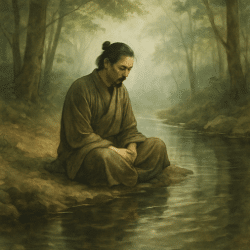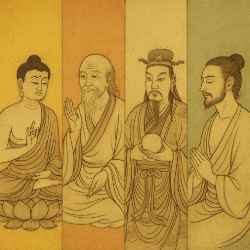“The mind is like water. When calm, it reflects clearly. When stirred, it becomes cloudy.”
Taoism has always examined the nature of the self with subtlety and care.
It speaks of layers, of depths unseen, of the difference between what we show and what we truly are.
This distinction—between the surface self and the deep self—is not a modern invention.
It is rooted in the ancient texts, shaped by meditation traditions, and refined through inner alchemy.
Let us walk through these teachings.
Slowly. Thoughtfully.
Like one crossing a quiet bridge at dawn.
The Surface Self: Conditioned and Reactive
We all have a face we show the world.
It smiles when it must.
It bristles when challenged.
It conforms to customs, rules, and expectations.
This is the surface self.
In Taoist terms, this is the conditioned mind.
It forms through social learning and habit.
It is useful—essential even—for living among others.
But it is shallow.
Reactive.
Easily disturbed.
Philosophical Taoists called this aspect of mind xin (心), often described as restless, scattered, like wind-blown dust.
“When the heart-mind is unsettled, the Tao cannot be seen.”
It is the surface that moves in every breeze.
It is the water that ripples at every touch.
It cannot reflect the sky clearly.
Zhuangzi and the Innate Nature (Xing)
The idea of depth—of something more authentic—appears clearly in the writings of Zhuangzi (Chuang Tzu), one of Taoism’s greatest philosophers.
Zhuangzi speaks of xing (性), our innate nature.
It is what is true before learning, unspoiled by fear, pride, or custom.
While the surface mind chases fame, approval, and fear, xing remains uncontrived.
It is natural.
Spontaneous.
Free.
Master Steenrod remarks:
“This is a classical Taoist idea. It’s not modern pop-psychology. The heart-mind is described as divided: surface mind reactive and social, true mind calm and rooted in the Tao.”
Zhuangzi urges us to practice the fasting of the heart (xin zhai):
Letting go of fixed judgments.
Calming the surface self so the true nature can emerge.
He calls us to sit in forgetfulness (zuo wang):
Forget the body.
Forget distinctions.
Forget the ego.
Return to simplicity.
“I am lost to myself, and the Tao enters me.”
This is not mystical obscurity for its own sake.
It is a method.
A way to peel away the social mind and encounter the deep self.
It is like autumn stripping leaves from a tree.
Not to destroy it,
But to reveal its form.
The Heart-Mind (Xin) in Meditation Traditions
As Taoism developed, especially in its meditation schools, the idea of the divided heart-mind became even clearer.
Manuals from the Tang and Song dynasties describe two aspects of xin:
Surface mind (fu xin): scattered, reactive, worldly.
True mind (zhen xin): calm, stable, rooted in Tao.
Meditation aims to unify these.
Or more precisely:
To descend from the surface to the depth.
Practitioners are instructed to:
Quiet thoughts like calming wind over water.
Focus breath until distractions fade.
Observe mind without grasping.
Let the true mind reveal itself naturally.
This is not repression.
It is clarification.
Allowing muddy water to settle.
“In stillness, clarity. In clarity, insight.”
In this way, Taoist meditation is gentle.
Patient.
Non-coercive.
It does not force the mind to be silent.
It invites it to rest.
Inner Alchemy: Formalizing the Deep Self
Later Taoist inner alchemy (neidan) developed even clearer language and methods.
It turned this division into a map for personal transformation.
Master Steenrod explains:
“Later alchemy texts are even more explicit about unifying this division. You’re training that reactive, scattered mind to return to something stable.”
Alchemical texts describe:
Surface mind as fire: flickering, consuming, unfocused.
True mind as water: yielding, cooling, clear.
Practices combine breath work, visualization, and physical stillness to harmonize these forces.
To unite heart and mind.
To stabilize the spirit (shen).
“Gather the spirit, calm the heart, return to the root.”
Alchemy is not merely about immortality.
It is about integration.
Stability.
Insight.
Freedom from compulsive reaction.
The “deep self” is not a different self.
It is the natural self revealed when false layers dissolve.
Why This Matters
Why speak of these distinctions?
Why bother with old metaphors?
Because modern life is full of surface living.
Constant reaction.
Image-making.
Fear of rejection.
Attachment to praise.
We see it in social media, in advertising, in politics.
The cultivation of surface mind is rewarded.
But it brings anxiety.
Confusion.
Disconnection from ourselves.
As Master Steenrod says:
“Meditation doesn’t kill the social mind, it clarifies it. It lets you respond from your real nature rather than conditioned fear or habit.”
This is the purpose:
To see the self clearly.
To choose action from the root, not from fear.
To live honestly, lightly.
A person who knows their deep self is stable.
Gentle.
Resilient.
Capable of genuine connection.
“Knowing others is intelligence. Knowing yourself is true wisdom.” — Laozi
Practicing the Descent to the Deep Self
How does one descend from surface to depth?
Taoist traditions offer many methods, but all share certain principles.
✅ Stillness
Sit quietly. Let breath slow.
✅ Observation
Notice thoughts without chasing them.
✅ Non-grasping
Let judgments fade.
✅ Naturalness (Ziran)
Do not force insights. Allow them to arise.
✅ Returning
Gently return attention when distracted.
A simple practice:
Sit.
Breathe slowly.
When thoughts come, greet them lightly.
Let them pass like clouds.
Return to the quiet.
This is fasting of the heart.
This is sitting in forgetfulness.
This is the gate to the deep self.
The Deep Self in Daily Life
Meditation is not the only realm for this.
Taoism encourages bringing it into ordinary life.
✅ Respond slowly.
✅ Listen fully.
✅ Act without forcing.
✅ Speak truthfully, without embellishment.
✅ Let go of needing to be seen a certain way.
These are small, radical acts.
They dismantle the surface self.
They nourish the deep self.
Like water carving stone.
Quietly. Persistently.
Conclusion: A Return to Simplicity
Taoism is not about creating new identities.
It is about letting go.
Unlearning.
Returning.
Surface self is not evil.
It is simply incomplete.
The deep self is not hidden.
It is simply quiet.
If we wish to find it,
We must be willing to slow down,
To listen,
To allow.
“Stand like a mountain. Flow like water. Shine like the moon.”
Frequently Asked Questions
What is the surface self in Taoism?
The surface self is the conditioned, reactive mind shaped by social learning. It is restless, scattered, and concerned with appearances rather than authenticity.
What is the deep self in Taoism?
The deep self is your innate nature, or xing. It is calm, authentic, and revealed through stillness, meditation, and naturalness, free from social conditioning.
How did Zhuangzi describe this?
Zhuangzi taught practices like "fasting of the heart" and "sitting in forgetfulness" to let go of the reactive surface mind and reveal true nature.
How does meditation help?
Meditation calms thoughts, fosters observation without grasping, and lets judgments fade. Through this, the true mind or deep self can naturally emerge.
Is this relevant today?
Yes. Modern life encourages surface mind—constant reaction and image-making. Taoist practice offers stability and authenticity by returning us to our natural, uncontrived mind.
Discover the Path to Real Taoist Practice
Are you exploring Taoist philosophy but unsure how to apply it in your life?
“Journey to the Tao: The First 33.5 Days” bridges the gap between reading the Tao Te Ching and living its wisdom. This course offers proven 1,500-year-old practices to help you:
- Master the principles of Te (spiritual power).
- Eliminate self-sabotage and align with your true nature.
- Build habits that enhance your spiritual and personal success.
Whether you’re new to Taoism or a seasoned seeker, this is your chance to make the Tao a living, daily experience.




